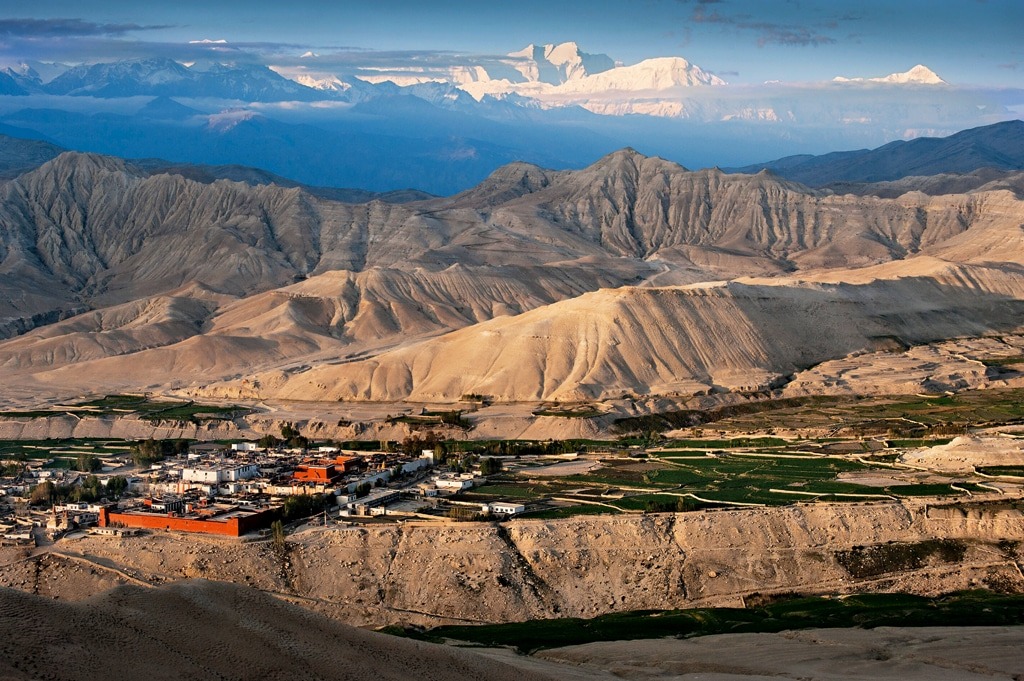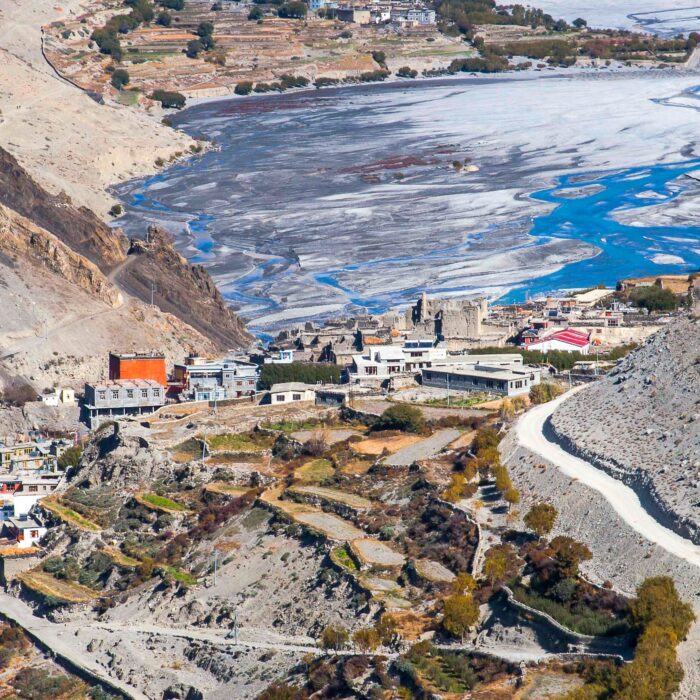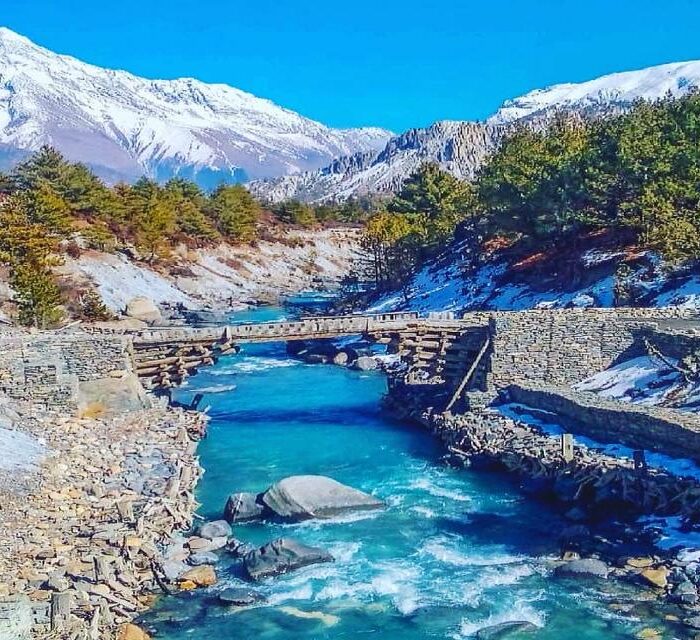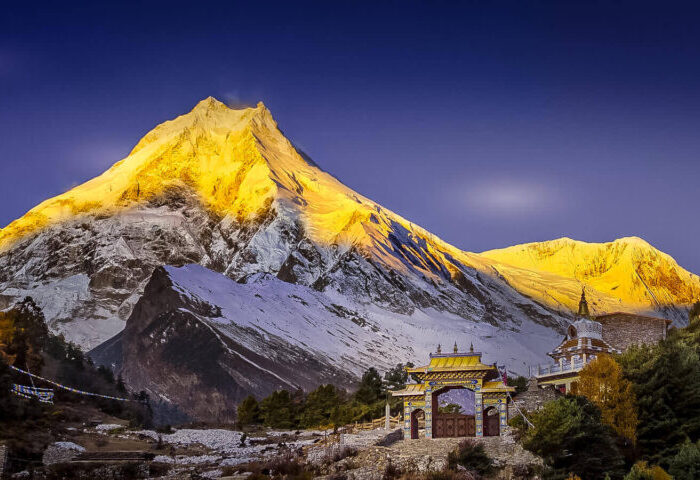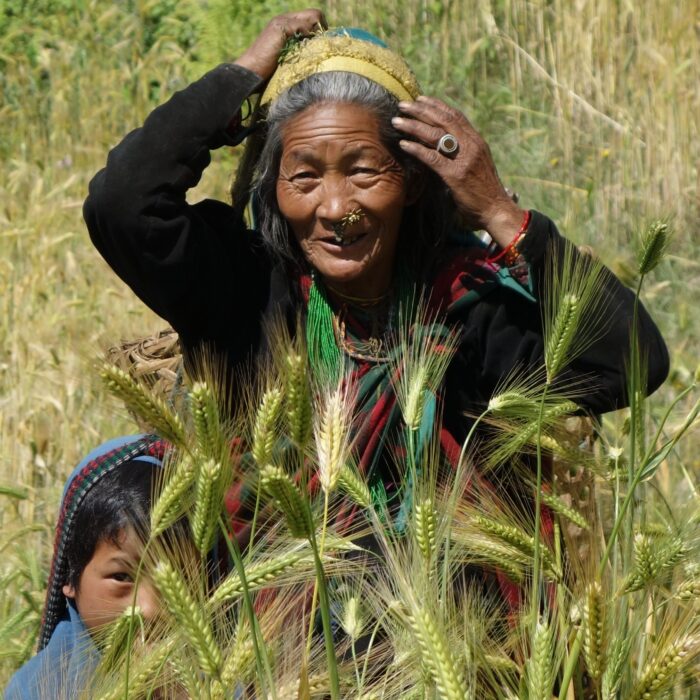The Upper Mustang 15-day trek is amazing in a faraway and socially rich part of Nepal. It is often called the “Last Forbidden Kingdom”. It’s in the northwest of Nepal, close to Tibet. Furthermore, it used to be the Kingdom of Lo because it was far and hard to reach. This trek will give you a special experience, letting you explore a distant and socially protected area of Nepal. Furthermore, enjoy the beautiful landscapes and find historical treasures along the way.
Upper Mustang Trek Information
The 15-day Upper Mustang trek offers a rich experience with its diverse culture, history, and beautiful nature. Its unique culture, urged by Tibet, shows in old monasteries, fancy prayer wheels, and vivid flags tuning up the land. Meanwhile, as you trek through this unique region, you’ll have the chance to visit historic sites like Lo Manthang. Furthermore, it is a walled city and the old capital of the Kingdom of Lo. People know it for its mighty fresh ancient design.
The trek will show you great views, like the grand Annapurna and Dhaulagiri mountains. They are set against dry landscapes and interesting rock formations. Also, there are famous caves, such as Lomanthang Cave and Nyphu Cave, with ancient Buddhist paintings and detailed images. They will give a peek into its long history. If you’re lucky and your timing is right, you might get to join in lively local festivals and events. Thus, making your cultural experience even more special on this incredible trek.
Altitude and Difficulty
The highest point is about 3800 m / 12, 467 feet, and worries about height are not as much as in higher treks. So, the trek is seen as fairly challenging. Similarly, Please check our trek equipment list. This list will be a guide for you if you plan to trek in Nepal. Similarly, you can check our AMC (Acute Mountain Sickness) which can be a good guide for you to learn more about getting ill at high heights in Nepal. Also, if you want to do a Peak climb in Nepal then please check the climbing equipment list that is a must while going on the Peak climb. Likewise, we suggest you check the updated TIMS card rule as there have been some new changes in Nepal.
Beyond Upper Mustang 15-day trek
Are you looking for other options other than the Upper Mustang trek? Explore other treks such as
Please check our trek equipment list. This list will be a guide for you if you plan to trek in Nepal. Similarly, you can check our AMC (Acute Mountain Sickness) which can be a good guide for you to learn more about getting ill on high heights in Nepal. Also, if you want to do a Peak climb in Nepal then please check the climbing equipment list that is a must while going on the Peak climb. Likewise, we suggest you check the updated TIMS card rule as there have been some new changes in Nepal.
How can I get a Nepal Visa?
You can get Nepal visas upon arrival at Tribhuvan International Airport. To make the process faster and avoid long lines, fill out the Online Nepal Visa form a week before you arrive. Bringing a printed copy with the proof number helps you get through Immigration faster. Make sure you have enough cash for the visa fee when you arrive, as the cost depends on how long you’re staying and how often you’re entering. Also, we suggest you check our tourist visa in Nepal as there have been some major changes.
Booking Open for 2024 / 2025
Are you planning to trek or tour in 2024? If so, then in our Best Deals part, you can find the ideal info on the best price for the trek or tour cost. Furthermore, book plans as soon as possible.
Contact us or Send a message or call us at
What’s App / Viber / Mobile: + 977 – 9851 022814, + 977 – 9841 451681
We are available 24 / 7
For further information, Contact us.
Itinerary
Day 1: Drive to Pokhara (820m / 2,690ft) west of the Kathmandu Valley
Following a hearty breakfast, we embark on a scenic journey to Pokhara via a comfortable tourist bus, a leisurely 6 to 7-hour drive. En route, our eyes are treated to the picturesque sights of the meandering Trishuli and Marsyangdi rivers, adding a touch of natural beauty to our voyage. As we approach Pokhara, the landscape transforms, revealing a stunning river valley that boasts unparalleled vistas. To the north, the mighty Annapurna and Machhapuchhre mountains dominate the skyline, while the imposing Dhaulagiri graces the western horizon. In the east, the towering Manaslu and Lamjung Himal ranges come into view, completing the panoramic spectacle. Pokhara, often hailed as a tourist’s haven, welcomes us with modern amenities and comforts, promising an unforgettable experience amidst its natural splendor.
Day 2: Fly from Pokhara to Jomsom (2,720m / 8,915ft) and trek to Kagbeni (2,800m / 9,500ft)
We catch an early morning flight to Jomsom for the clearest mountain views, including the impressive Dhaulagiri and Annapurna peaks. Our journey commences in Jomsom, the district headquarters of Mustang, as we follow a scenic trail along the arid Kali Gandaki River valley. Our path leads us to Kagbeni, an ancient trading hub with a Buddhist monastery, situated just south of Upper Mustang’s restricted area, all beneath a breathtaking landscape.
Day 3: Trek from Kagbeni (2,800m / 9,500ft) to Chele (3,055m / 10,025ft). We will start the Upper Mustang Trek adventure today.
Beyond Kagbeni lies Upper Mustang, an area requiring a special permit for entry, and our journey continues after registering our documents at the gateway check post. We kick off our trek early in the morning, opting for the eastern bank of the Kali Gandaki River to avoid the gusty Mustang winds that sweep through in the afternoons. The sunrise treats us to spectacular views of Mt. Nilgiri, bathed in a warm orange hue. As we traverse the riverbank, dust fills the air, necessitating sunglasses and, perhaps, a face mask for comfort. Along the way, we encounter Mustang’s distinctive red sandstone pillars and rock formations, shaped over millennia by relentless erosion. Our path leads us to Tangbe Village, a charming hamlet adorned with red and whitewashed homes, idyllic apple orchards, and swaying barley fields. Continuing through a narrow canyon, we arrive at Chele, perched along a ridge, where the vistas are nothing short of otherworldly. The views here are truly unparalleled, offering a glimpse of a landscape unlike any other on Earth.
Day 4: Trek from Chele (3,055m / 10,025ft) to Syangboche (3,930m / 11,400ft)
This day’s trek presents a significant challenge, as we ascend approximately 800 meters in elevation gain. Starting from Chele, our path leads us up a steep spur and continues through a rugged canyon, eventually reaching Eklo Bhatti. Further ascent brings us to the Taklam La pass, standing at an altitude of 3,625 meters (11,940 feet). Crossing this high pass leads us to the village of Samar, where we are treated to breathtaking views of Mount Nilgiri. Samar also serves as a common resting place for horses and mule caravans. Descending from Samar, we navigate a vast gorge, passing by the striking Rangchyung Chorten adorned with vibrant red, black, yellow, and white hues. Our journey then takes us to Syangboche, marking another leg of our memorable trek.
Day 5: Trek from Syangboche (3,930m / 11,400ft) to Ghami (3,520m / 11,535ft)
Our day commences with an ascent toward yet another mountain pass, the Yamada La Pass, situated at an elevation of 3,845 meters (12,655 feet). The trek takes us through a mesmerizing desert landscape, dotted with a handful of remote settlements that seem almost otherworldly. The trail gradually climbs to a vast valley before descending to the expansive barley fields of Gelling. Here, the houses, fashioned from mud and stone, bear the traditional white and ochre hues typical of Mustang.
Our journey continues from Gelling, leading us to the charming settlement of Tama Gaun. From there, we ascend once more, this time reaching the Nyi La Pass at an impressive altitude of 4,015 meters (13,205 feet). Our descent from this pass takes us to the village of Ghami, where we will find respite and marvel at the captivating landscapes that have accompanied us throughout this incredible trek.
Day 6: Trek from Ghami (3,520m / 11,535ft) to Tsarang (3505m / 11,500ft)
Our trek on this day leads us through the most arid and parched terrain of Mustang. The challenging ascent is met with awe-inspiring views of the heavenly countryside, making every step worthwhile. Our ultimate destination is Tsarang, a sprawling town with approximately 1,000 residents. Here, amidst this vast and captivating landscape, we find a welcoming haven to rest and reflect on the remarkable journey through the heart of Mustang.
Day 7: Trek from Tsarang (3505m / 11,500ft) to Lo Manthang (3810m / 12,135ft)
Our day’s journey kicks off on level terrain before ascending once again, this time conquering the Lo La Pass. From this vantage point, you are treated to delightful vistas of the valley below, including the captivating sight of Lo Manthang. Our descent from the Lo La Pass brings us into Lo Manthang, with our approach from the northern entrance adding an intriguing dimension to our exploration of this ancient walled city.
Day 8: Rest and exploration day in Lo Manthang
Today, you have the privilege of exploring the historical marvel that is Lo Manthang—a walled city boasting around 150 houses, steeped in a rich history dating back to the 1390s. Lo Manthang served as the fortified capital of the Kingdom of Lo since its establishment in 1380 by Ame Pal. This village is renowned for its towering whitewashed mud-brick walls, monasteries (Gompas), and the royal palace.
The crowning jewel of Lo Manthang is the royal palace, a remarkable nine-cornered, five-story structure that has stood since around 1400—an architectural masterpiece of its time. The town is also home to four significant temples: Jampa Gompa (Jampa Lhakhang), Thubchen Gompa, Chodey Gompa, and Choprang Gompa. Among them, Jampa Gompa, also known as God’s house, stands as the oldest. Similarly, Choprang Gompa, referred to as New Gompa, holds its significance.
It’s worth noting that while Upper Mustang was opened to foreigners by the Nepalese government in 1992, tourism to this extraordinary region remains limited even today, preserving its mystical allure and cultural heritage for those fortunate enough to visit.
Day 9: Trek from Lo Manthang (3,810m / 12,135ft) to Ghami (3,520m / 5,577ft)
Departing from Lo Manthang, our route leads us southward toward Kagbeni, but this time we opt for a different path than the one that brought us to Lo Manthang. Our trek takes us through the village of Drakmar, and along the way, we make a point to visit the renowned Ghar Monastery, adorned with stunning wall paintings that tell their tales. As our journey unfolds, we eventually arrive at Ghami, marking another leg of our memorable trek through the captivating landscapes of Mustang.
Day 10: Trek from Ghami (3,520m / 5,577ft) to Samar (3,700m / 12,139ft)
Our trek unfolds through the remote and arid terrain with a sense of reverence, allowing us to fully immerse ourselves in the enchanting vistas that surround our path. We ascend to reach the Chemi La and Yiy La passes before descending steeply to reach Geling. Beyond Gelling, the descent becomes more gradual as we journey onward to Syangboche. However, our final destination for the day awaits us in Samar—a village reminiscent of Tibetan style, adorned with mani walls, a serene monastery, and terraced fields that paint a captivating portrait of this remarkable region.
Day 11: Trek from Samar (3,700m / 12,139ft) to Chhusang (2,980m / 9,776ft)
Leaving Samar behind, we now merge with the well-traveled trekking trail en route to Chhusang. Following the trail, we gradually descend to the Kali Gandaki riverbed, where our journey takes us through a remarkable rock tunnel. Beyond the tunnel lies Chhusang, our destination for the day, beckoning with its unique charm and the ever-flowing Kali Gandaki River, which continues to accompany us on this unforgettable journey.
Day 12: Trek from Chhusang (2,980m / 9,776ft) to Muktinath (3,760m / 12,335ft)
Today’s adventure takes us across the Gyu La Pass, standing at an elevation of 4,077 meters. While following the renowned Annapurna Circuit, this pass offers a distinctive perspective as we traverse it from a different direction. From this vantage point, your eyes are treated to a panorama of majestic Himalayan peaks stretching northward into Tibet, while glancing behind reveals the magnificent Annapurna range.
Our trail leads us through a succession of ancient villages, each exuding its unique charm, before eventually reaching Muktinath—a sacred site revered by both Hindus and Buddhists alike. Known as ‘Chumig Gyatsa’ in Tibetan, Muktinath translates to “A Hundred Waters,” aptly describing the spiritual significance of this place. Within the walled Muktinath temple complex, you’ll discover a harmonious blend of cultures, featuring a Buddhist monastery, several Hindu shrines, 108 bathing spouts, and an eternal flame—a testament to the deep spiritual heritage that thrives in this sacred oasis.
Day 13: Trek from Muktinath (3,760m /12,335ft) to Jomsom (2,720m/8,915ft)
On this final day of our trekking adventure, we make our descent to Jharkot and Khingar, both adorned with beautiful monasteries that offer a glimpse into the spiritual heart of the region. As we continue our journey, the landscape gradually transforms as we lose elevation, eventually reuniting with Jomsom, nestled at the base of the Kali Gandaki River Valley. The atmosphere here marks a striking departure from the serene trails and remote villages we’ve encountered throughout our trek, as the bustling market area of Jomsom greets us with a vibrant and lively scene, bringing our remarkable journey to a memorable conclusion.
Day 14: Early morning flight from Jomsom to Pokhara (820m / 2,690ft) (and optional flight back to Kathmandu).
With hearts filled with memories of Mustang, we bid farewell to this captivating region and embark on an early morning flight that carries us over the southern Kali Gandaki Valley to the picturesque city of Pokhara. Here, you have the choice to either catch a flight back to Kathmandu or take a day to explore the attractions of Pokhara—a renowned tourist hub in Nepal, ensuring your journey ends on a note of adventure and exploration.
Day 15: Drive from Pokhara (820m / 2,690ft) to Kathmandu (1,350m / 4,450ft) 6-7hrs
Our journey homeward commences as we board a tourist bus for the return to Kathmandu, tracing a 200-kilometer route that initially parallels the Marsyangdi River before following the course of the Trishuli River. For those seeking a quicker return, a 25-minute flight option is available (not included in the package). As we arrive in Kathmandu, our trek package comes to a close, leaving you with cherished memories of your incredible journey through the Mustang region.
Frequently Asked Questions (FAQ)
Q1. Where is the Upper Mustang located?
Upper Mustang is a remote region located in the north-central part of Nepal, bordering Tibet. It lies in the rain shadow of the Annapurna and Dhaulagiri mountain ranges.
Q2. Why Upper Mustang is called a “Forbidden Kingdom”?
Upper Mustang was once a restricted area that required special permits for entry. This policy earned it the nickname “Forbidden Kingdom.” It was opened to foreign tourists in 1992, but permits are still required, and tourism is regulated to preserve its unique culture and environment.
Q3. What permits do I need to visit Upper Mustang?
To visit the Upper Mustang, you need two permits: the Annapurna Conservation Area Permit (ACAP) and the Upper Mustang Restricted Area Permit. You can obtain these permits through registered trekking agencies in Nepal.
Q4. When is the best time to trek in the Upper Mustang?
The best time to trek in Upper Mustang is during the spring (April to June) and autumn (September to November) when the weather is generally stable, and the skies are clear. These months offer excellent visibility and comfortable temperatures.
Q5. How long does it take to complete the Upper Mustang trek?
The typical duration of the Upper Mustang trek is around 10 to 14 days, depending on the specific itinerary and starting/ending points. The trek can be customized to your preferences and time constraints.
Q6. What is the maximum altitude reached during the Upper Mustang trek?
The highest point on the Upper Mustang trek is typically the Lo La Pass, which stands at an altitude of approximately 4,100 meters (13,451 feet) above sea level.
Q7. Is it possible to trek independently in the Upper Mustang?
No, independent trekking is not allowed in Upper Mustang. You must be accompanied by a registered guide, and you need to obtain the necessary permits through a registered trekking agency.
Q8. What is the culture like in Upper Mustang?
Upper Mustang has a unique Tibetan-influenced culture with ancient monasteries, chortens, prayer flags, and traditional practices. The people of Upper Mustang are predominantly of Tibetan descent and follow Buddhism.
Q9. Are there accommodation and food options available along the trek?
Yes, there are teahouses and lodges in the villages along the Upper Mustang trekking route where you can find accommodation and meals. However, facilities may be more basic compared to more popular trekking regions in Nepal.
Q10. Is it necessary to be physically fit for the Upper Mustang trek?
Yes, a reasonable level of fitness is required for the Upper Mustang trek, as it involves walking at high altitudes and across varied terrain. It’s recommended to engage in some physical preparation before undertaking the trek.
Q11. Can I extend my trek to other regions after completing the Upper Mustang trek?
Yes, you can combine your Upper Mustang trek with other nearby treks like the Annapurna Circuit or explore different parts of Nepal, depending on your interests and the time available.

